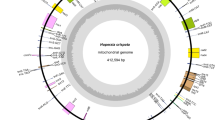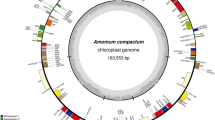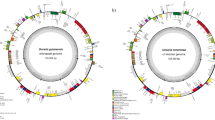Abstract
Background
Huperzia crispata, belonging to the Huperziaceae family, is one of the most essential resources of huperzine A for candidate drugs to treat Alzheimer’s diseases. However, there is very limited information about H. crispat, and its taxonomic status and interspecific relationships between Huperzia species are still unclear. To investigate the taxonomic classification of Huperzia species and identify species discrimination markers, the complete chloroplast (cp) genome of H. crispata was sequenced and characterized for the first time.
Methods and Results
Total genomic DNA was isolated and sequenced using the next-generation Illumina NovaSeq 6000 platform. The data were filtered, assembled and annotated by a series software and web service. The results were as follows: the cp genome of H. crispata was 154,320 bp long with a large single-copy (LSC) region of 104,023 bp, a small single-copy (SSC) region of 19,671 bp, and a pair of inverted repeat (IRa and IRb) regions of 15,313 bp. A total of 131 genes, including 87 protein-coding genes, 36 transfer RNA genes (tRNAs), and eight ribosome RNA genes (rRNAs), were annotated in the cp genome. The contraction and expansion of the inverted repeat (IR) regions were relatively conserved in the Huperzia genus. Codon usage bias analysis showed that the encoding rate at the 3-end of codon A/T (74.34%) was significantly higher than that of C/G (25.66%). A total of 8 hotspot loci with high Pi values (> 0.06) were identified in the four Huperzia species based on nucleic acid diversity analysis. Ka/Ks selective pressure analysis demonstrated that the cemA gene is the most common gene undergoing positive selection among Huperzia. In addition, a total of 261 simple sequence repeats and 179 interspersed repeats were identified in the cp genome. Phylogenetic tree analysis based on the complete protein sequences of 23 related species of H. crispata indicated that H. serrata f. longipetiolata is a sister of H. crispata, suggesting that H. serrata f. longipetiolata and H. crispata are more closely related than H. serrata and H. lucidula.
Conclusions
The results strongly supported that H. crispata was more closely related to H. serrata f. longipetiolata than to H. serrata and H. lucidula within the Huperzia genus. The outcome provided important information for the phylogenetic analysis of the subsequent specific molecular species identification in Huperzia. The present results will provide valuable information for further research into the classification, phylogeny and species identification of Huperzia plants.





Similar content being viewed by others
Data Availability
The cp genome sequence data of H. crispata that support the findings of this study are openly available in NCBI at the GenBank database with accession number ON745420 (https://www.ncbi.nlm.nih.gov).
References
Luca VD, Pierre BS (2000) The cell and developmental biology of alkaloid biosynthesis. Trends Plant Sci 5:168–173
Tang XC, Han YF (2006) Pharmacological profile of huperzine A, a novel acetylcholinesterase inhibitor from Chinese herb. CNS Drug Rev 5:281–300
Ha GT, Wong RK, Zhang Y (2011) Huperzine A as potential treatment of Alzheimer’s disease: an assessment on chemistry, pharmacology, and clinical studies. Chem Biodivers 8:1189–1204
Takayama H (2015) Recent progress in total synthesis of Lycopodium alkaloids. J Syn Org Chem Jpn 73:1072–1080
Wang ZY, Liu JG, Li H, Yang HM (2016) Pharmacological effects of active components of Chinese herbal medicine in the treatment of Alzheimer’s disease: a review. Am J Chin Med 4:1525–1541
Howes MR, Fang R, Houghton PJ (2017) Effect of Chinese herbal medicine on Alzheimer’s disease. Int Rev Neurobiol 135:29–56
Sang X, Yang M, Su J (2020) Research on endophytic fungi for producing huperzine A on a large-scale. Crit Rev Microbiol 46:654–664
Khanal P, Zargari F, Far BF, Kumar DRM, Mahdi YK, Jubair NK, Saraf SK, Bansal P, Singh R, Selvaraja M, Dey YN (2021) Integration of system biology tools to investigate Huperzine A as an anti-Alzheimer agent. Front Pharmacol 12:785964
Ma X, Tan C, Zhu D, Gang DR (2006) A survey of potential huperzine A natural resources in China: the Huperziaceae. J Ethnopharmacol 104:54–67
Chen SS, Zhang MH, Wang JX, Zhang XC (2021) Original plant and research progress of the medicinal plant Huperzia javanica. Guihaia 41:1794–1809 (Chinese with English abstract)
Zhang LB, Iwatsuki K (2013) Lycopodiaceae. In: Wu ZY, Raven PH, Hong DY (eds) Flora of China, vol 2–3 (Lycopodiaceae through Polypodiaceae). Science Press, Beijing & Missouri Botanical Garden Press, St. Louis
Wolf PG, Karol KG, Mandoli DF, Kuehl J, Arumuganathan K, Ellis MW, Mishler BD, Kelch DG, Olmstead RG, Boore JL (2005) The first complete chloroplast genome sequence of a lycophyte, Huperzia lucidula (Lycopodiaceae). Gene 350:117–128
Guo ZY, Zhang HR, Shrestha N, Zhang XC (2016) Complete chloroplast genome of a valuable medicinal plant, Huperzia serrate (Lycopodiaceae), and comparison with its congener. Appl. Plant Sci. 4:1600071
Zhang HR, Kang JS, Viane RLL, Zhang XC (2017) The complete chloroplast genome sequence of Huperzia javanica (sw.) C. Y. Yang in Lycopodiaceae. Mitochondrial DNA B Resour. 2:216–218
Asada K (2006) Production and scavenging of reactive oxygen species in chloroplasts and their functions. Plant Physiol 141:391–396
Li JY, Yang C, Tian YY, Liu JX (2022) Regulation of chloroplast development and function at adverse temperatures in plants. Plant Cell Physiol 63:580–591
Daniell H, Lin CS, Yu M, Chang WJ (2016) Chloroplast genomes: diversity, evolution, and applications in genetic engineering. Genome Biol 17:134
Provan J, Powell W, Hollingsworth PM (2001) Chloroplast microsatellites: new tools for studies in plant ecology and evolution. Trends Ecol Evol 16:142–147
Langmead B, Salzberg SL (2012) Fast gapped- read alignment with Bowtie 2. Nat Methods 9:357–359
Bankevich A, Nurk S, Antipov D, Gurevich AA, Dvorkin M, Kulikov AS, Lesin VM, Nikolenko SI, Pham S, Prjibelski AD, Pyshkin AV, Sirotkin AV, Vyahhi N, Tesler G, Alekseyev MA, Pevzner PA (2012) SPAdes: a new genome assembly algorithm and its applications to single-cell sequencing. J Comput Biol 19:455–477
Boetzer M, Pirovano W (2012) Toward almost closed genomes with GapFiller. Genome Biol 13:R56
Laslett D, Canback B (2004) ARAGORN, a program to detect tRNA genes and tmRNA genes in nucleotide sequences. Nucleic Acids Res 32:11–16
Kumar S, Stecher G, Tamura K (2016) MEGA7: molecular evolutionary genetics analysis version 7.0 for bigger datasets. Mol Biol Evol 33:1870–1874
Sheikh-Assadi M, Naderi R, Kafi M, Fatahi R, Salami SA, Shariati V (2022) Complete chloroplast genome of Lilium ledebourii (Baker) Boiss and its comparative analysis: lights into selective pressure and adaptive evolution. Sci Rep 12:9375
Amiryousefi A, Hyvonen J, Poczai P (2018) IRscope: an online program to visualize the junction sites of chloroplast genomes. Bioinformatics 34:3030–3031
Katoh K, Standley DM (2013) MAFFT multiple sequence alignment software version 7: improvements in performance and usability. Mol Biol Evol 30:772–780
Rozas J, Ferrer-Mata A, Sanchez-DelBarrio JC, Guirao-Rico S, Librado P, Ramos-Onsins SE, Sanchez-Gracia A (2017) DnaSP 6: DNA sequence polymorphism analysis of large data sets. Mol Biol Evol 34:3299–3302
Beier S, Thiel T, Münch T, Scholz U, Mascher M (2017) MISAweb: a web server for microsatellite prediction. Bioinformatics 33:2583–2585
Letunic I, Bork P (2021) Interactive Tree of Life (iTOL) v5: an online tool for phylogenetic tree display and annotation. Nucleic Acids Res 49(W1):W293–W296
Mower JP, Ma PF, Grewe F, Taylor A, Michael TP, Qiu VR, Y.L. (2019) Lycophyte plastid genomics: extreme variation in GC, gene and intron content and multiple inversions between a direct and inverted orientation of the rRNA repeat. New Phytol 222:1061–1075
Shim H, Lee HJ, Lee J, Lee HO, Kim JH, Yang TJ, Kim NS (2021) Plastid genomes of the early vascular plant genus Selaginella have unusual direct repeat structures and drastically reduced gene numbers. Int J Mol Sci 22:641
Sharp PM, Li WH (1987) The codon adaptation index-a measure of directional synonymous codon usage bias, and its potential applications. Nucleic Acids Res 15:1281–1295
Dong S, Ying Z, Yu S, Wang Q, Liao G, Ge Y, Cheng R (2021) Complete chloroplast genome of Stephania tetrandra (Menispermaceae) from Zhejiang Province: insights into molecular structures, comparative genome analysis, mutational hotspots and phylogenetic relationships. BMC Genom 22:880
Chen H, Chen Z, Du Q, Jiang M, Wang B, Liu C (2022) Complete chloroplast genome of Campsis grandiflora (Thunb.) schum and systematic and comparative analysis within the family Bignoniaceae. Mol Biol Rep 49:3085–3098
Du Q, Jiang M, Sun S, Wang L, Liu S, Jiang C, Gao H, Chen H, Li Y, Wang B, Liu C (2022) The complete chloroplast genome sequence of Clerodendranthus spicatus, a medicinal plant for preventing and treating kidney diseases from Lamiaceae family. Mol Biol Rep 49:3073–3083
Qin Z, Cai ZQ, Xia GM, Wang MC (2013) Synonymous codon usage bias is correlative to intron number and shows disequilibrium among exons in plants. BioMed Central 14:56
Ahmed I, Biggs PJ, Matthews PJ, Collins LJ, Hendy MD, Lockhart PJ (2012) Mutational dynamics of aroid chloroplast genomes. Genome Biol Evol 4:1316–1323
Dong W, Liu J, Yu J, Wang L, Zhou S (2012) Highly variable chloroplast markers for evaluating plant phylogeny at low taxonomic levels and for DNA barcoding. PLoS ONE 7:e35071
Chen Q, Wu X, Zhang D (2020) Comparison of the abilities of universal, super, and specific DNA barcodes to discriminate among the original species of Fritillariae cirrhosae bulbus and its adulterants. PLoS ONE 15:e0229181
Li WH, Wu CI, Luo CC (1985) A new method for estimating synonymous and nonsynonymous rates of nucleotide substitution considering the relative likelihood of nucleotide and codon changes. Mol Biol Evol 2:150–174
Wicke S, Schneeweiss GM, dePamphilis CW, Müller KF, Quandt D (2011) The evolution of the plastid chromosome in land plants: gene content, gene order, gene function. Plant Mol Bio 76:273–297
McDonald MJ, Wang WC, Huang HD, Leu JY (2011) Clusters of nucleotide substitutions and insertion/deletion mutations are associated with repeat sequences. PLoS Biol 9:e1000622
Yang J, Zhang J, Han R, Zhang F, Mao A, Luo J, Dong B, Liu H, Tang H, Zhang J, Wen C (2019) Target SSR-Seq: a novel SSR genotyping technology associate with perfect SSRs in genetic analysis of cucumber varieties. Front Plant Sci 10:531
Bauret L, Field AR, Gaudeul M, Selosse MA, Rouhan G (2018) First insights on the biogeographical history of Phlegmariurus (Lycopodiaceae), with a focus on Madagascar. Mol Phylogenet Evol 127:488–501
Luo T, Li Y, Yuan X, Wang Y (2019) The complete chloroplast genome sequence of Phlegmariurus carinatus. Mitochondrial DNA B Resour 4:3977–3978
Tang LM, Jiang RH, An JC (2020) The complete chloroplast genome of Phlegmariurus phlegmaria, one representative species of genus Phlegmariurus. Mitochondrial DNA B Resour 5:3418–3419
Funding
This work was financially supported by the Key Research and Development Program of Zhejiang Province (Grant No. 2021C02043), the Yuyao Science and Technology Planning Project (Grant No. JHNS20210304) and the Zhejiang Sci-Tech University scientific research fund (Grant No. 19042142-Y).
Author information
Authors and Affiliations
Contributions
DY, BP, QJ and DW: developed the concept and designed the lab experiments. DY, BP, HL, QL, YZ, NM, TC and HS: performed the experiments. DY and DW: wrote the paper. QJ and DW: edited the paper. All authors have read and agreed to the published version of the manuscript.
Corresponding author
Ethics declarations
Conflict of interest
The authors declare no conflict of interest.
Additional information
Publisher's Note
Springer Nature remains neutral with regard to jurisdictional claims in published maps and institutional affiliations.
Supplementary Information
Below is the link to the electronic supplementary material.
Rights and permissions
Springer Nature or its licensor holds exclusive rights to this article under a publishing agreement with the author(s) or other rightsholder(s); author self-archiving of the accepted manuscript version of this article is solely governed by the terms of such publishing agreement and applicable law.
About this article
Cite this article
Yin, D., Pang, B., Li, H. et al. The complete chloroplast genome of the medical plant Huperzia crispata from the Huperziaceae family: structure, comparative analysis, and phylogenetic relationships. Mol Biol Rep 49, 11729–11741 (2022). https://doi.org/10.1007/s11033-022-07979-w
Received:
Accepted:
Published:
Issue Date:
DOI: https://doi.org/10.1007/s11033-022-07979-w




